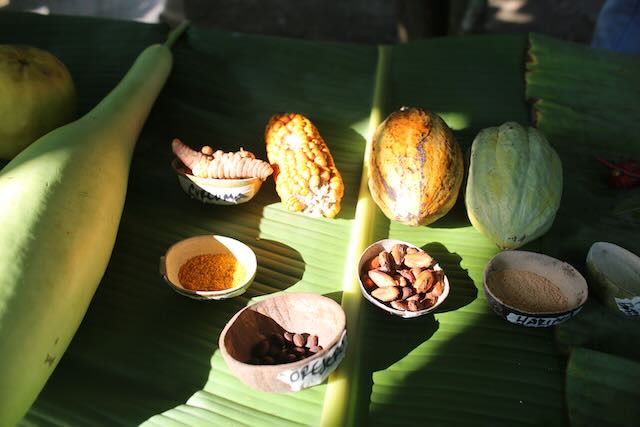While the world appears to be on fire, both literally and figuratively—from the Israel-Hamas conflict to the Sudan civil war, to our own country's political woes, it feels almost trivial to write about a rose. Yet there is symbolism in a rose, and particularly the one from Morocco, in its thorny reality, the women rose pickers, some of them young, some of them seemingly ancient, their hands and arms covered to prevent being ripped by the sharp shrubs, the roses opening softly in the early morning light, their scent hanging in the air like a beautiful question mark.
What will become of us humans, messing around on this fragile, exquisite tangle of a planet?
May 1, 2024 Drive to Dadés Valley:
Early start from Marrakech. Call to prayer woke me up at 5 am. We lug our bags out through a maze of streets. Cats and bread carts. Long drive...up into and through the Atlas mountains. Variety of crazy rocks!
We stop for a moment at sunrise for coffee. Side of the road. Poppies blooming, wheat. A sign for a hairdresser, the Arabic letters graceful as flowers.
I traveled to Morocco, a place I've longed to visit for years, to attend the annual Festival of the Roses, and to visit our cooperative farmers, a women's co-op that I met in 2020 at a trade fair, and have since been communicating with over WhatsApp. Much of Morocco's landscape is desert, but it is flecked with oases, beautiful valleys where water collects and allows a variety of plants to grow, including that of the Damask Rose, which traveled from Syria some 500 odd years ago, and thrives in the heat and conditions of the oasis. I am also here to make another short film that chronicles the stories of women in the spice trade. I have a small team with me, Nick August-Perna, our director, Jude Chehab, our fixer, Magela Crosignani, our cinematographer, Anas, our PA, and Muhammad, our driver. We make a motley crew, and I love it.
May 2, 2024
Co-op now - tired! I've been doling out Advil to various people with headaches. The women are happy we are here. They smile a lot and show us around. It is windy, soft. Sunny. The inner rooms - tiled, filled to the brim with roses. Sweet and jammy, rich. I've never seen anything like this in my life.
12 flags of Morocco outside, flapping exuberance - brought in for the festival. A man comes to drill a hole in the wall, hang a picture of the king.
All 4 women are named Fatima
We booked this trip last minute since they don't announce the festival dates until about 3 weeks prior. It's dependent on the blooming of the roses. They bloom for only about a month, and an intense production takes place. Over 70 co-ops dot the valley, and ours is one of the well-established ones, so they received an honorable visit from the Minister of Agriculture. Great fanfare. We stayed in a hotel that was under construction because everything else was completely booked. Not by tourists, we seemed to be some of the only foreigners, but by locals coming from all around. Our rooms were spotless, the courtyard was an active site of cement mixers, wires, machines, a dark green pool taking shape. The hotel owner was so eager to please us he set up a fanciful tea party amidst the rubble to greet us when we returned the first day, weary from trekking around the oasis. We sat at the white table cloth and ate snacks and drank tea well into the night.
May 3, 2024
Weird day. Tried to get into the festival tents but everyone needed badges. So we stood in the hot sun being nudged by officials, playing phone tag with Anas who was trying to get the passes. Nothing, then he got one! But why? Like a convention.
Over lunch we learned our driver had the mumps. He'd been complaining of an ear ache, and his face is swollen. We all looked it up on our phones, discussed immunity and MMR vaccines. We ate wrinkly black olives and bread, sipped tea out of glass cups. A police officer at a neighboring table fed scraps of food to a hungry cat.
Back at the co-op, we're taking a break in the kitchen when we hear a startling, loud humming sound, like a jet engine at close proximity. The women around me who were drinking tea jump to their feet and run towards a back building, their hijabs flying behind them. They enter a shed where there is some large machinery, a furnace perhaps and someone is able to stop the sound. One of the younger women, she is maybe 20 years old, slides down a wall, weeping. I assume with fear and panic about what just happened. The other women slap her on the cheek and throw glasses of water on her face.
The aroma of rose is omnipresent. I sip warm rose water from the tank. My feet are swollen and hot. I can't speak any of the languages. I'm exhausted and annoyed. The women are exhausted from hosting the minister of Agriculture. The sun is hot.
We head out early one morning to visit a rose field, tucked away in a tiny village called Dwar Hdida. It feels like a movie set (in fact, Lawrence of Arabia was filmed not far from here) and as the sun rises, the shadows are crisp lines across the desert, striking against the blue sky.
We follow along in a field where women quietly pluck the roses, the sound of birds is loud, the fig trees drooping across pathways, the cliffs rising in the background in biblical proportions.
I learn later that Drissia, the head of the co-op, was the first woman in her community to go to school. People said to her parents "why are you sending her to school? You should have her work in the fields" She has been working with women here, helping them find education and jobs, for 29 years.
While Salou prepares beef, Drissia prays in the corner.
Marinate overnight without the onion (only garlic) then cook with rose and then finish with honey.
Serve with basmati rice cooked with cardamom and served with raisins.
Saloua cuts her finger while preparing the beef. She says 'eiiii' and then keeps dipping it in ground black pepper. One of the women insists on pressing the finger into her palm to stop the bleeding.
The scene reminds me of all the women that surrounded me when I gave birth to my second child. The warmth and intensity, the pain and the comfort.
May 4, 2024
Drissia is passionate - she sometimes runs out of breath when she speaks.
Henna dyed fingertips.
Heavy gold rings.
Dogs fighting in the background,
sun slanting,
metal door banging in the wind.
We circle around.
"Regenerate the oasis."
Intense blue sky,
dusky purple mountains.
Powerful women. Gold-speckled head scarf.
Orange clay buildings
Rebuild the ecosystem.
She speaks in Amazigh - called Berber before,
but that means barbarian.
What does the rose mean to her?
Drissia tells me:
"I don't want to know any other rose."


























































